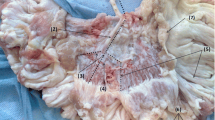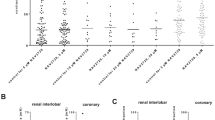Abstract
As previously reported, Nω-nitro-l-arginine (l-NNA), an inhibitor of nitric oxide (NO) synthesis, decreased transmural field stimulation (TFS)-induced noradrenaline overflow from the isolated perfused rat mesenteric vasculature attached to the intestine. The decrease was attenuated by l-arginine. This suggests that NO may increase noradrenaline release (Yamamoto et al. 1993).
The present experiments with this preparation were done in order to monitor changes in vascular perfusion pressure caused by TFS or by noradrenaline infusion in parallel with those in the noradrenaline outflow caused by TFS in the presence of atropine (0.1 μmol/l) (to block acetylcholine-induced release of endothelial NO) and of indomethacin (3 μmol/l) (to inhibit l-NNA-induced production of vasoconstrictor prostanoids). (1) TFS (2–10 Hz) caused a frequency-dependent increase in noradrenaline overflow and perfusion pressure. (2) l-NNA (10 and 30 μmol/l) caused a concentration-dependent inhibition of TFS-induced noradrenaline overflow, whereas the TFS-induced pressure increase was augmented by l-NNA in a concentration-dependent manner. At any given concentration of l-NNA, the potentiation of vasoconstriction by l-NNA became greater in magnitude as the frequency of the TFS was raised. (3) Infusion of noradrenaline (0.38–6 nmol) caused a dose-dependent increase in perfusion pressure up to a value comparable with that caused by TITS. The pressure increase in response to noradrenaline infusion was also enhanced by l-NNA, relatively, to a greater extent than the enhancement, by l-NNA, of the pressure response to TFS. (4) These effects of l-NNA were significantly attenuated by l-arginine (0.3 mmol/l) or sodium nitroprusside (1 μmol/l). Our results suggest that NO, presumably originating from several sites, may stimulate the release of noradrenaline in the mesenteric vasculature and that the consequent rise in circulating noradrenaline, in turn, causes the liberation of endothelial NO.
Similar content being viewed by others
References
Angus JA, Cocks TM, Satoh K (1986) α2 Adrenoceptors and endothelium-dependent relaxation in canine large arteries. Br J Pharmacol 88:67–777
Bult H, Boeckxstaens GE, Pelckmans PA, Jordaens FH, Van Maercke YM, Herman AG (1990) Nitric oxide as an inhibitory non-adrenergic non-cholinergic neurotransmitter. Nature 345:346–347
Cederqvist B, Wiklund NP, Persson MG, Gustafsson LE (1991) Modulation of neuroeffector transmission in the guinea pig pulmonary artery by endogenous nitric oxide. Neuroscience Lett 127:67–69
Cohen RA, Weisbrod RM (1988) Endothelium inhibits norepinephrine release from adrenergic nerves of rabbit carotid artery. Am J Physiol 254:H871-H878
Gonzalez C, Fernandez A, Martin C, Moncada S, Estrada C (1992) Nitric oxide from endothelium and smooth muscle modulates responses to sympathetic nerve stimulation: Implications for endotoxin shock. Biochem Biophys Res Commun 186:150–156
Greenberg S, Diecke FPJ, Peevy K, Tanaka TP (1989) The endothelium modulates adrenergic neurotransmission to canine pulmonary arteries and veins. Eur J Pharmacol 162:67–80
Greenberg S, Diecke FPJ, Peevy K, Tanaka TP (1990) Release of norepinephrine from adrenergic nerve endings of blood vessels is modulated by endothelium-derived relaxing factor. Am J Hypertension 3:211–218
Ignarro LJ (1989) Biological actions and properties of endothelium-derived nitric oxide formed and released from artery and vein. Circ Res 65:1–21
Kowaluk EA, Seth P, Fung H-L (1992) Metabolic activation of sodium nitroprusside to nitric oxide in vascular smooth muscle. J Pharmacol Exp Ther 262:916–922
Lee TJ-F, Sarwinski S (1991) Nitric oxidergic neurogenic vasodilation in the porcine basilar artery. Blood Vessels 28:407–412
Lot TY, Stark G, Wilson VG (1993) Endothelium-dependent contractions to NG-nitro-l-arginine methyl ester in the porcine isolated splenic artery are sensitive to cyclooxygenase and lipoxygenase inhibitors. Naunyn Schmiedebergs Arch Pharmacol 347:115–118
Marks GS, McLaughlin BE, Brown LB, Beaton DE, Booth BP, Nakatsu K, Brien JF (1991) Interaction of glyceryl trinitrate and sodium nitroprusside with bovine pulmonary vein homogenate and 10000×g supernatant: Biotransformation and nitric oxide formation. Can J Physiol Pharmacol 69:889–892
Miller VA, Vanhoutte PM (1985) Endothelial alpha-2 adrenoceptors in canine pulmonary and systemic blood vessels. Eur J Pharmacol 118:123–129
Moncada S, Palmer RMJ, Higgs EA (1991) Nitric oxide: physiology, pathophysiology, and pharmacology. Pharmacol Rev 43:109–142
Moritoki H, Ueda H, Yamamoto T, Hisayama T, Takeuchi S (1991) l-Arginine induces relaxation of rat aorta possibly through non-endothelial nitric oxide formation. Br J Pharmacol 102:841–846
Ohno M, Ochiai M, Taguchi J, Hara K, Akatsuka N, Kurokawa K (1990) Stretch may enhance the release of endothelium-derived relaxing factor in rabbit aorta. Biochem Biophys Res Commun 173:1038–1042
Palmer RMJ, Rees DD, Ashton DS, Moncada S (1988) l-Arginine the physiological precursor for the formation of nitric oxide in endothelium-dependent relaxation. Biochem Biophys Res Commun 153: 1251–1256
Pegoraro AA, Carretero OA, Sigmon DH, Beierwaltes WH (1992) Sympathetic modulation of endothelium-derived relaxing factor. Hypertension 19:643–647
Rees DD, Cellek S, Palmer RMJ, Moncada S (1990) Dexamethasone prevents the induction by endotoxin of a nitric oxide synthase and the associated effects on vascular tone: An insight into endotoxin shock. Biochem Biophys Res Commun 173:541–547
Rubanyi GM, Romero JC, Vanhoutte PM (1986) Flow-induced release of endothelium-derived relaxing factor. Am J Physiol 250: H1145-H1149
Shinozuka K, Kobayashi Y, Shimoura K, Hattori K (1992) Role of nitric oxide from the endothelium on the neurogenic contractile responses ] of rabbit pulmonary artery. Eur J Pharmacol 222:113 -120
Smith SS, Li J (1993) Novel action of nitric oxide as mediator of N-methyl-d-aspartate-induced phosphatidylinositol hydrolysis in neonatal rat cerebellum. Mol Pharmacol 43:1–5
Toda N, Okamura T (1992) Mechanism of neurally induced monkey mesenteric artery relaxation and contraction. Hypertension 19:161–166
Toda N, Yoshida K, Okamura T (1991) Analysis of the potentiating action of NG-nitro-l-arginine on the contraction of the dog temporal artery elicited by transmural stimulation of noradrenergic nerves. Naunyn Schmiedebergs Arch Pharmacol 343:221–224
Vo PA, Reid JJ, Rand MJ (1992) Attenuation of vasoconstriction by endogenous nitric oxide in rat caudal artery. Br J Pharmacol 107:1121–1228
Yamamoto R, Cline WH Jr (1987) Release of endogenous NE from the mesenteric vasculature of WKY and SHR in response to PNS. J Pharmacol Exp Ther 241:826–832
Yamamoto R, Wada A, Asada Y, Niina H, Sumiyoshi A (1993) Nω-Nitro-l-arginine, an inhibitor of nitric oxide synthesis, decreases noradrenaline outflow in rat isolated perfused mesenteric vasculature. Naunyn Schmiedebergs Arch Pharmacol 347:238–240
Author information
Authors and Affiliations
Additional information
Correspondence to: R. Yamamoto at the above address
Rights and permissions
About this article
Cite this article
Yamamoto, R., Wada, A., Asada, Y. et al. Functional relation between nitric oxide and noradrenaline for the modulation of vascular tone in rat mesenteric vasculature. Naunyn-Schmiedeberg’s Arch Pharmacol 349, 362–366 (1994). https://doi.org/10.1007/BF00170881
Received:
Accepted:
Published:
Issue Date:
DOI: https://doi.org/10.1007/BF00170881




